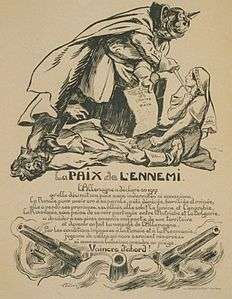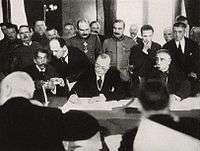Treaty of Bucharest (1918)
|
Romanian Prime-Minister Alexandru Marghiloman signing the treaty | |
| Signed | 7 May 1918 |
|---|---|
| Location | Buftea, Romania |
| Condition | Ratification by Romania and the Central Powers |
| Signatories |
|
| Languages | German |
The Treaty of Bucharest was a peace treaty between Romania on one side and the Central Powers on the other, following the stalemate reached after the campaign of 1916–17 and Romania's isolation after Russia's unilateral exit from World War I (see Treaty of Brest-Litovsk). It was signed at Buftea, near Bucharest, on 7 May 1918.
Terms
- Romania had to return Southern Dobruja (the Cadrilater) and to cede the southern part of Northern Dobruja (see the maps) to Bulgaria, while the rest of the province remained under the joint control of the Central Powers.
- Romania had to give Austria-Hungary control of the passes of the Carpathian Mountains (see the maps).
- Romania had to lease its oil wells to Germany for 90 years.
- The Central Powers recognized the Union of Bessarabia with Romania[1]
- German civil servants with the power to veto decisions by Romanian cabinet ministers and to fire Romanian civil servants were appointed to oversee every Romanian ministry, in effect stripping Romania of its independence.[2]
Aftermath
Alexandru Marghiloman signed the treaty at Buftea (near Bucharest) on 7 May 1918 and it was ratified by the Chamber of Deputies on 28 June and by the Senate on 4 July 1918. However, King Ferdinand I of Romania refused to sign it.
The treaty put Romania in a unique situation compared to the other German occupied countries. It completely respected Romanian de jure independence, as it did not impose any form of vassalage or protectorate over Romania, and even though the country had to cede land, it still emerged bigger than before entering the war, thanks to the Union with Bessarabia.
Although Bulgaria received a part of Northern Dobruja, it continued to lobby Germany and Austria-Hungary for the annexation of the whole province, including the condominium established by the Treaty of Bucharest. After negotiations, a protocol regarding the transfer of the jointly administered zone in Northern Dobruja to Bulgaria was signed in Berlin, on 25 September 1918, by Germany, Austria-Hungary, the Ottoman Empire and Bulgaria. In compensation, Bulgaria agreed to cede the left bank of the Maritsa river to Turkey. However, this agreement was short-lived because after 4 days, on 29 September Bulgaria had to capitulate in the face of the advancing Allied forces (see also the Armistice with Bulgaria).
The treaty was denounced in October 1918 by the Alexandru Marghiloman government and subsequently nullified by the terms of the Armistice of 11 November 1918.
In 1919, Germany was forced in the Treaty of Versailles to renounce all the benefits provided by the Treaty of Bucharest in 1918.[3] The territorial transfers to Austria-Hungary and Bulgaria were annulled by the treaties of Saint-Germain (1919), Neuilly (1919) and Trianon (1920), respectively.
Maps
 Map of Dobruja
Map of Dobruja- Romanian territories ceded to Austria-Hungary (purple), Bulgaria (blue) and the Central Powers (green) through the Treaty of Bucharest. These changes were reversed by the Treaty of Versailles.
Image gallery
 Foreign Minister of Austria-Hungary, Stephan Burián von Rajecz, signing the treaty
Foreign Minister of Austria-Hungary, Stephan Burián von Rajecz, signing the treaty.jpeg) Picture taken at the signing of the treaty (Bulgarian State Archives)
Picture taken at the signing of the treaty (Bulgarian State Archives) Delegates at the treaty
Delegates at the treaty French caricature on the Romanian-German peace: Kaiser Wilhelm II pointing a dagger at a woman (Romania), while showing her the terms of the treaty and stepping on the corpse of a man (Russia)
French caricature on the Romanian-German peace: Kaiser Wilhelm II pointing a dagger at a woman (Romania), while showing her the terms of the treaty and stepping on the corpse of a man (Russia)
See also
- Romania during World War I
- Treaty of Bucharest, 1812
- Treaty of Bucharest, 1913
- Treaty of Bucharest, 1916
References
- ↑ R. J. Crampton, Eastern Europe in the twentieth century, Routledge, 1994, ISBN 978-0-415-05346-4, p. 24–25
- ↑ Kitchen, Martin "Hindenburg, Ludendorff and Rumania" pages 214-222 from The Slavonic and East European Review, Volume 54, Issue # 2, April 1976 page 223.
- ↑ Articles 248–263 - World War I Document Archive
External links
| Wikimedia Commons has media related to Treaty of Bucharest (1918). |
- Full text of the Treaty of Bucharest
- The Treaty of Bucharest on FirstWorldWar.com
- Territory which was ceded to the Austro-Hungarian Empire by Romania following the Treaty of Bucharest, 1918



